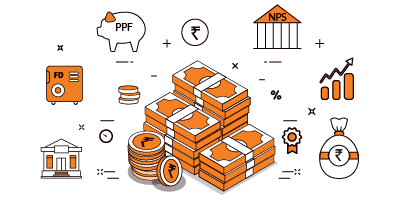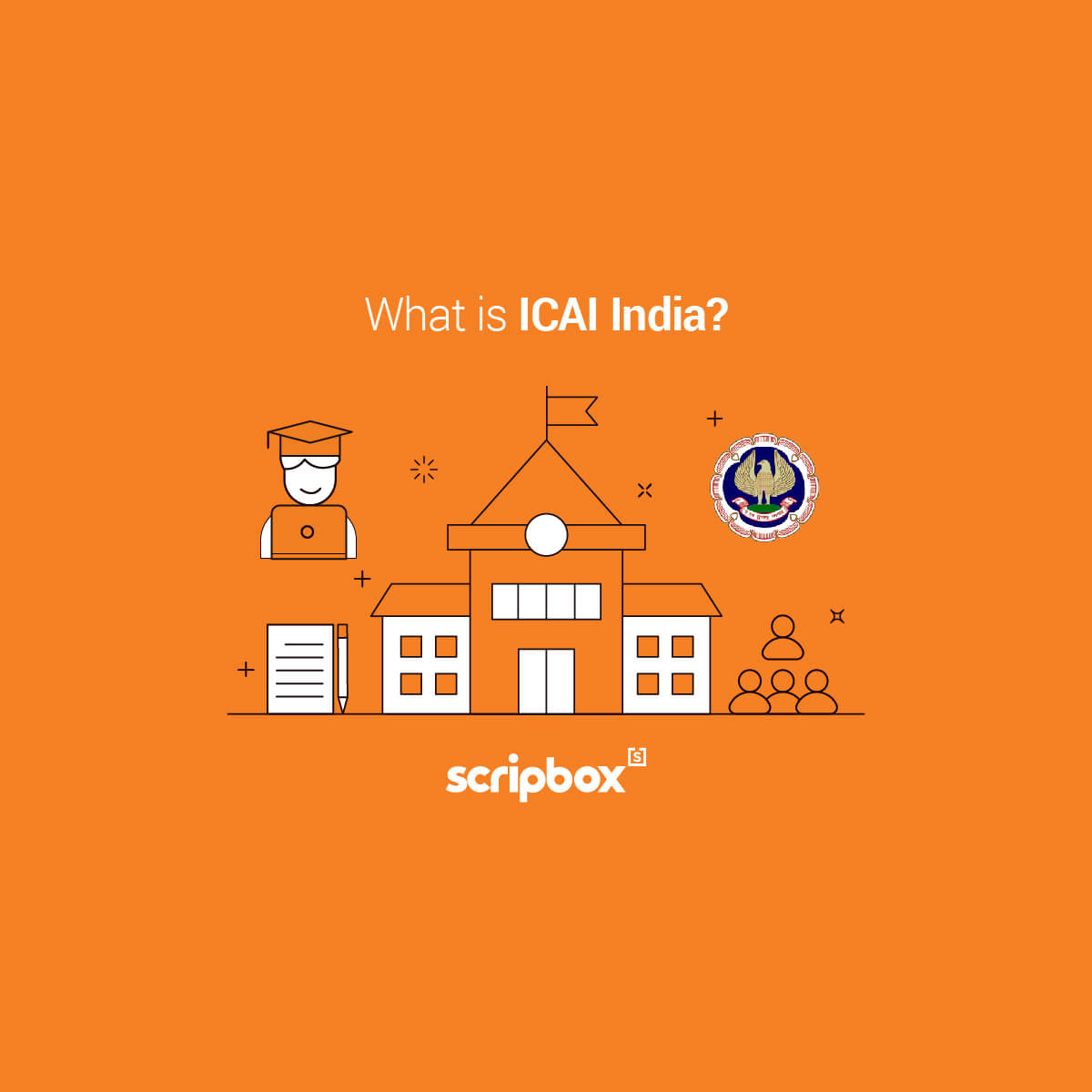What is an Investment?
Investments are assets that allow money to grow. Investments are made with an intention to benefit from the appreciation of value over time. They generate income in two ways for investors. Firstly, investors can sell it and earn from capital gains. Secondly, investors can earn from regular income in the form of interest or dividends.
There are different types of investments in the financial market. The most common one is investing in stocks through stock exchanges, corporate bonds, fixed deposits, real estate and gold. Investments come with a level of risk. Different types of investments have different types of risks. Investors can invest in multiple assets (investments) and create a diversified portfolio that will earn them good returns. A well-diversified portfolio helps in reducing the overall portfolio risk.
How Investment Works?
Investing refers to acquiring an asset today to benefit from it in the future. Investors invest money with an intent to generate money either through capital appreciation over time or through regular income from the investment. Investing includes the purchase of shares, bonds, and property or machinery to produce goods. It also includes investing in education that will help earn knowledge and improve skills that will help earn income in the future.
Investing involves a certain level of risk. Investors invest for future growth, but there is always a chance that the investments might lose value. The companies one invested in might go bankrupt, leading to loss of investors’ money. Hence investors have to practice caution before investing.
Investors have to assess their investment goals and align them with the investment objectives of several investments. Finally, they can choose the one that best fits their requirements. After investing, investors have to monitor their investment portfolio continuously and realign it, if necessary. If investors lack the time and knowledge to do so, they can always take financial advisors’ help. Financial advisors help investors to select the best investments that suit them and also continuously monitor them. They charge a small fee for the services they provide.
Why Should you Invest your Money?
Saving money from every paycheck creates a savings fund. However, having savings in one’s bank account will earn little to no interest in the long run. This is because the savings account doesn’t give inflation beating returns. Hence leading to loss of purchasing power. And in the long run, one might end up losing money by just saving it. By investing, investors can make money work for them. The main objective of investing is to earn future income. Also, investments will help meet unexpected and unforeseen expenses and aid in times of any emergency. Below are the reasons why one should invest money.
- Aid in times of emergency: Investments can be liquidated easily, and they act as an aid in times of any emergency. One can sell their assets or take a loan against them.
- Meet future financial goals: Investors invest with an aim to achieve future financial goals like retirement or buying a car or house. Investing now can benefit investors by helping them meet their future financial goals. Hence investors have to do financial planning and invest strategically towards achieving their goals.
- Have a secure future: Investing will assure a secure future. Investing provides a second source of income. Hence, even in times of loss of income, investors can use their investments to aid them financially until they find another source of income. Moreover, investments can help secure the future of an investor.
Types of Investment options in India
List of Market linked investments
Market linked investments are those investments whose return is dependent on the market. In other words, if the market is performing well, the returns from these investments are good. Below are the most popular investments with market linked returns.
1. Stocks
The most common equity investment is investing in stocks through stock exchanges. Investors invest in stocks with a motive to earn from capital gains, as well as earn regular income through dividends. Investors benefit when the share prices of the stocks they invested go up. But there is always a chance that investors can lose the money they invested.
Since the returns from stocks are market linked, these are the riskiest investments. Share prices fluctuate every day on the stock market, and hence investors should invest in stocks with a long term investment horizon. Investors have to practice patience with this equity investment.
One needs a demat and trading account to invest in equities and trade on the stock market. A demat account will hold that share while a trading account will facilitate the trade. Returns from investing in shares are taxable. Short term capital gains are taxable at 15%. At the same time, long term capital gains are taxable at 10% (if the gains are above INR 1 lakh) per annum.
2. Mutual Funds
Mutual funds are investment vehicles that pool money from investors with similar objectives. They invest in equity and debt instruments like shares, government bonds and corporate bonds strategically. A portfolio manager or a fund manager manages the mutual fund portfolio.
The portfolio of the mutual fund is based on its investment objective. Mutual funds differ based on the asset class, its investment objective, etc. The main categories of mutual funds are equity mutual funds, debt mutual funds, hybrid funds. Equity funds invest in shares, debt mutual funds invest in debt securities, and hybrid funds invest in equity and debt securities. There are also equity mutual funds that offer tax benefits. These are ELSS funds (Equity Linked Savings Scheme) and investment in these equity funds qualify for tax exemption under Section 80C of the Income Tax Act, 1961.
Returns from mutual funds can be calculated using the mutual fund calculator. One can use a SIP calculator or lumpsum returns calculator to estimate their returns from mutual funds. Also, the returns from mutual funds are taxable. Short term capital gains of an equity fund are taxable at 15%. At the same time, long term capital gains are taxable at 10%, if the gains are more than INR 1,00,000 per annum. For debt mutual funds, the short term gains are taxable as individual investors income tax slabs rates. While long term capital gains are taxable at 10% without indexation benefit and 20% with indexation benefit.
3. National Pension Scheme (NPS)
National Pension System is a retirement scheme backed by the government. These investment avenues are for investors who want to save for retirement and at the same time, save tax. Investors have to invest in the National Pension System during the tenure of their employment. And they can withdraw a part of their investment at the time of retirement while the rest is used to buy an annuity. With an annuity, the investor can receive a fixed amount of money every month.
NPS returns are market linked as investors have to choose fund managers and asset classes based on their age. However, they are low risk investments as the government backs them. Returns from the NPS scheme can be calculated using the NPS calculator. Scripbox’s NPS calculator is free to use and is available online. NPS has two accounts, Tier I, a default account and Tier II, a voluntary account. Investments in NPS qualify for tax exemption to INR 2 lakhs under Section 80C, and 80CCD of the Income Tax Act, 1961.
Upon maturity, only 60% of the accumulated money can be withdrawn. The remaining 40% is used to buy an annuity. The entire 60% amount is tax-free in the hands of investors.
List of Fixed return investments
Fixed return investments are those whose returns aren’t dependent on the market. In other words, investors get a fixed and guaranteed return by investing in this type of investment scheme. Below are a few of the popular fixed return investments.
1. Fixed Deposit
A fixed deposit is among the widely used savings investments that offers fixed returns to investors. The tenure of an FD varies between seven days to ten years. The depositor invests a lump sum amount at the beginning of the tenure for the scheme’s entire duration. The minimum investment amount for bank fixed deposits is INR 100, and also there is no limit on the maximum investment amount.
Furthermore, fixed deposits offer guaranteed returns and are the most popular investment vehicles. Banks and financial institutions offer fixed deposits, and the FD rate ranges between 3%-7%. Also, senior citizen depositors are offered an additional FD rate of 0.5% on their bank fixed deposits. One can estimate the interest and maturity amount on FDs using a fixed deposit calculator. Scripbox’s fixed deposit calculator is free to use and is available online.
Investments in tax saving FDs qualify for tax exemption under Section 80C of the Income Tax Act, 1961. However, investments in all other FDs do not qualify for a tax deduction. The interest income is taxable as per individual investor’s income tax slab rates. Moreover, the interest income is subject to TDS of 10%, if the PAN Card is submitted, and 20% if the Pan card isn’t submitted. And the TDS threshold limit is INR 40,000 for regular investors and INR 50,000 for senior citizen investors. Investors can estimate tax liability using Scripbox’s income tax calculator. The income tax calculator is available online and also is free to use.
2. Recurring Deposit
Recurring deposits are popular savings options that offer fixed interest on deposits. These investment avenues allow individuals to save a small fixed amount regularly on a monthly basis. The RD interest rates are predetermined, and upon maturity, one gets a lump sum amount. The recurring deposit tenure ranges between six months to ten years.
The interest in RD investment plans is compounded on a quarterly basis. The RD rates vary from bank to bank, as the interest rates are based on the tenure of the deposit and deposit amount. In India, the RD interest rates are in the range of 3.50% to 8.50%. Furthermore, senior citizen depositors are eligible for additional interest rates. One can estimate the maturity amount and interest earned from an RD investment using Scripbox’s RD Calculator. Returns from RDs are taxable as per individual investor’s income tax slab rates.
3. Post Office Schemes
Post office savings schemes are offered by India Post. The Government of India backs all the schemes, and hence the returns are guaranteed. Furthermore, some schemes offer tax benefits up to INR 1,50,000 under Section 80C of the Income Tax Act, 1961. Following are the schemes that the Post office offers:
- Post Office Savings Account
- 5-Year Post Office Recurring Deposit Account (RD)
- Post Office Time Deposit Account (TD)
- Post Office Monthly Income Scheme Account (MIS)
- Senior Citizen Savings Scheme (SCSS)
- Public Provident Fund Account (PPF)
- National Savings Certificates (NSC)
- Kisan Vikas Patra (KVP)
- Sukanya Samriddhi Accounts (SSA)
4. Public Provident Fund (PPF) and Employee Provident Fund (EPF)
Public Provident Fund is launched by the National Savings Institute and is one of the post office savings schemes. Also, some nationalised and private banks are authorised to accept these investments. The government backs it, and hence returns are guaranteed. The interest rate on PPF for the current quarter is 7.10% (January – March 2021). The interest payments are made on 31st March every year. PPF has a lock-in period of 15 years. Also, one can further extend the scheme in blocks of five years. All citizens of India can invest in PPF. However, HUFs and NRIs cannot open a PPF account.
Ministry of Labour regulates Employee Provident Fund, a Government of India scheme. It comes under the purview of the Employee Provident Fund and Miscellaneous Provisions Act,1952. Employee Provident Fund Organisation (EPFO) manages the savings scheme.
EPF aims to build a sufficient retirement corpus for an individual. The fund comprises monetary contributions from both employer and employee. Each of them contributes 12% of the employee’s basic salary (Basic + Dearness allowance) towards the fund every month. On retirement, the employee receives the entire contribution (of both employee and employer) as a lump sum with interest. Furthermore, the interest accrued is tax-free.
Explore: Different Types of Investments
Investment vs Savings
It goes without a saying that financial security is what one wishes for. How they achieve, that totally depends on their personal choices. One can choose to do it by way of investing or by saving. Investing is buying stocks, mutual funds, bonds, real estate, etc., with an expectation of generating good returns in the future. Investing is a long-term activity that helps in achieving financial goals. Access to money primarily depends on the kind of investments. Few investments come with a lock in period, while some can be easily redeemed. Investments have certain risks associated with them. However, in the long term, the effect of these will become less. Returns from investing are significant, and one can easily achieve their financial goals.
On the other hand, saving means holding cash or setting aside by parking it in an extremely safe account. In other words, it means setting aside money for the future and not using it. For example, one can save their money in a savings bank account or hold it in the form of cash or in liquid mutual funds. This ideally does not earn any returns or profits. Also, its value appreciation will be stagnant. Therefore, savings are typically to meet small financial objectives. Savings come in handy during critical situations. One can easily access their savings. Savings are low or zero risk investments. Risk of losing money is very low in comparison to other investment products. Interest on a savings account is often lower in comparison to other products. Hence returns from savings are very low or sometimes even nil.
Learn: Which Investment is best in India?
Differences between Investment and Savings:
| Parameter | Investment | Savings |
| Meaning | Process of putting money to use such that it grows | Putting money aside in a bank account for unexpected emergencies |
| Products | Investment can be in stocks, mutual funds, real estate, gold, etc. | Savings bank account or liquid mutual fund |
| Purpose | To earn returns and capital appreciation. | To fulfil short term needs and emergencies. |
| Tenure | Long term, 3+ years | Short term |
| Returns | Comparatively high | No or very less |
| Liquidity | Comparatively high | Highly liquid |
How should I invest my money?
The first step in investing is to identify the assets that best suit investment needs. It is important to align the investment goals with an asset. Investor’s profile, duration of the investment, risk tolerance levels also play an important role in deciding the asset. The following steps act as a guide for investing money:
Identify goals
It is always advisable to identify goals and invest in achieving them. In other words, investors have to do financial planning and investment planning. Always, categorise goals as long term goals and short-term goals that will help in investing in a suitable product for achieving them. For example, for long term goals such as buying a house, saving for child’s education or marriage, and retirement planning will help in generating significant returns.
Shortlist investments
With a wide range of investment options available, one should carefully research about all the products and pick the ones that best suit their profile, investment objective and tenure. For example, to create an emergency fund, one can invest in liquid mutual funds that offer better returns than a savings bank account. For tax saving purposes, one can invest in PPF, SSY, or ELSS mutual funds, etc., that qualify for tax exemption under Section 80C of the Income Tax Act 1961. Also, it is important not to invest in too many products. It leads to over diversification. This may have an impact on the overall returns of the portfolio.
Invest and review periodically
Investing in the right scheme doesn’t mean that it is the end of the process. One should periodically review and rebalance their portfolio. It is important to make necessary changes to the portfolio with the ever-changing market dynamics.
The above steps may seem to be easy. However, it requires good financial knowledge and time. Therefore, one can always hire a financial consultant to do all the research and hard work for you. Scripbox is an online investing platform that enables individuals to invest in the right products and help them realise their goals.
Read More:
- What is expense ratio
- What are stocks
- What is annual return
- What is annual yield
- What are different types of investment
- What is an Investment?
- Confused if your portfolio is performing right enough to meet your goals?
- How long have you been investing in mutual funds?
- What is your current portfolio size?
- What is your approximate annual household income?
- Your profile does not qualify for a call with a Financial Expert.
- How Investment Works?
- Why Should you Invest your Money?
- Types of Investment options in India
- Investment vs Savings
- Differences between Investment and Savings:
- How should I invest my money?
























Show comments